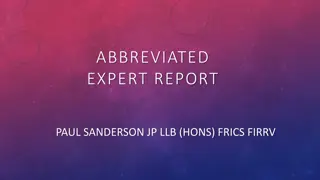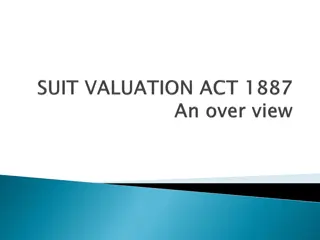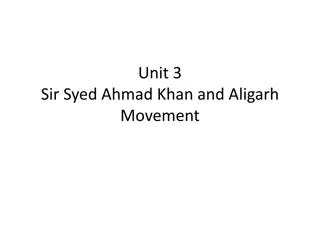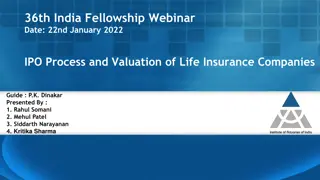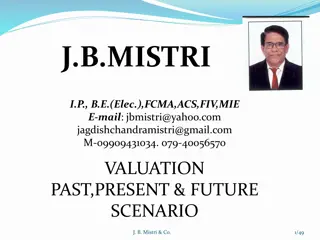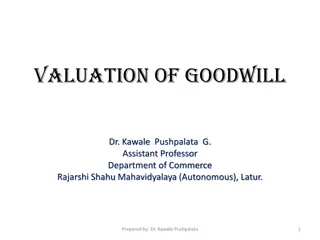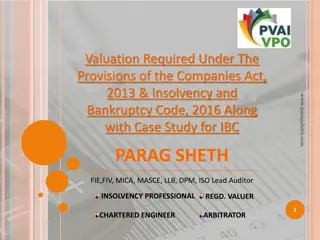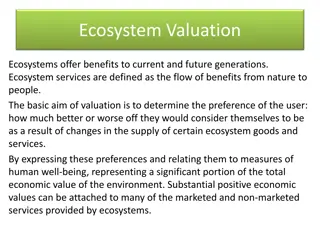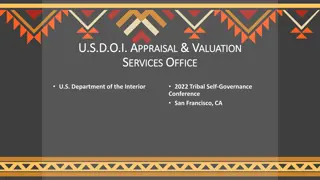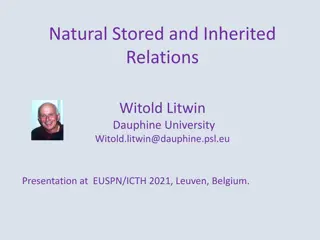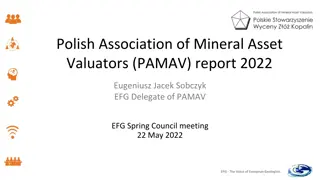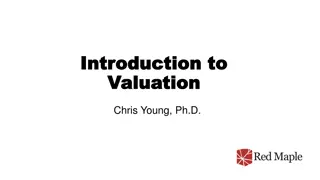
Basis of Value and Fair Market Value in Valuation Practices
Explore the concepts of Basis of Value (BOV) and Fair Market Value (FMV) in valuation practices, including key terms and definitions essential for harmonizing worldwide valuation standards. Learn about hypothetical buyer and seller scenarios, cash equivalence, and factors influencing FMV determination.
Download Presentation

Please find below an Image/Link to download the presentation.
The content on the website is provided AS IS for your information and personal use only. It may not be sold, licensed, or shared on other websites without obtaining consent from the author. If you encounter any issues during the download, it is possible that the publisher has removed the file from their server.
You are allowed to download the files provided on this website for personal or commercial use, subject to the condition that they are used lawfully. All files are the property of their respective owners.
The content on the website is provided AS IS for your information and personal use only. It may not be sold, licensed, or shared on other websites without obtaining consent from the author.
E N D
Presentation Transcript
RSV CA Rajiv Singh FCA, CISA(USA), RV, LIII Director Union Bank of India Course Director IVCP
Bases of Value(BOV) Session 2 RSV
IVS 2020 A milestone towards harmonizing valuation practices worldwide IVS 2020 Five General Standards Seven Asset Standards IVS 101 SOW IVS 102 I&C IVS 103 Reporting IVS 104 BOV IVS 105 Valuation Approaches & Methods IVS 200 Business & Business interest IVS 210 Intangible IVS 220 Non-Financial Liabilities IVS 300 P&E IVS 400 RPI IVS 410 DP IVS 500 FI
BOV FMV FMV (IGBVT) The price expressed in a) terms of cash equivalent b) at which property would change hands c) between a hypothetical willing and able buyer and a hypothetical willing and able seller d) acting at arm s length e) in an open and unrestricted market f) when neither is under compulsion to buy or sell g) when both have reasonable knowledge of the relevant facts RSV
BOV FMV Key terms in the FMV (IGBVT) definition a) the price b) cash equivalent c) Hypothetical, willing and able buyer & seller d) acting at arm s length e) an open and unrestricted market f) neither under compulsion to buy or sell g) both have reasonable knowledge of the relevant facts RSV
BOV FMV a) the price in the definition reflects to estimated amount or most probable price Buyer s price [most advantageous price] Seller s price [best price] Most probable price An unilateral offer cannot represent the FMV. RSV
BOV FMV b) Cash equivalent Determine the equivalent of cash that would be paid on the valuation date c) Hypothetical, willing and able buyer & seller Hypothetical seller and buyer indicate that actual identity of seller and buyer both is unknown and not relevant [this means they are not actual buyer and seller] Precludes the assumption of a specific buyer A price would not be considered representative of FMV if influenced by special motivations not characteristics of a typical buyer or seller RSV
BOV FMV d) Acting at arm s length relationship of parties to one another in market Arm s length adds element of separation and independence e) Open and unrestricted market Open: An assumption that no potential buyers are excluded and that a market exists Unrestricted: How the attributes of the property which restricts its marketability are to be dealt with notionally RSV
BOV FMV f) Neither party under compulsion to act If a seller is not under compulsion, he will not accept distress price If buyer is not under compulsion he will not pay the best price (that is over price) g) Reasonable knowledge of relevant facts How much potentially relevant information should be assumed to hypothetical parties? RSV
BOV FMV What FMV (IGBVT) Contemplates Does not contemplates Plan to sell to a particular buyer and adopted strategy Buyer have specific knowledge Engagement of experienced and well connected negotiator to get a favorable deal Other benefits attached with the deal like making available finance or key persons Price is cash or cash equivalent Price is an estimated amount Willingness & ability to buy & sell exist No compulsion to accept the deal Reasonable knowledge and time exist No separate price for not to compete RSV
BOV FMV FMV (US IRS) a) The price at which b) the parties would change hands c) between a willing buyer and a willing seller d) neither being under any compulsion to buy or to sell e) and both having reasonable knowledge of relevant facts RSV
BOV Market Value Market Value (IVS defined) a) The estimated amount b) for which an asset or liability should exchange c) on the valuation date d) between a willing buyer and a willing seller e) in an arm s length transaction f) after proper marketing and g) where the parties had each acted knowledgeably, prudently and without compulsion RSV
BOV Market Value Market Value (IVS defined) Key components: (a)The estimated amount (b)The transaction (c)The valuation date (d)The parties (e)The marketing (f) What parties should consider RSV
BOV FMV Market Value (IVS defined) a) The value (the estimated amount) the most probable price excludes amount due to any special terms or circumstances b) The transaction should exchange refers to hypothetical transaction (rather than actual sale price) the word should convey that sense of reasonable expectation in a hypothetical transaction c) On the date of valuation estimated value be specific to a given date refers to the date at which the valuation is concluded RSV
BOV FMV Market Value (IVS defined) d) Parties between a willing buyer and a willing seller they are not related parties Present owner ( actual) is the part of the market in the buyer category the buyer is not explicitly stated to be hypothetical The seller is a hypothetical owner requirement that both be willing to make the transaction creates the tension between them market value is independent and uninfluenced by the objectives of the Client RSV
BOV FMV Market Value (IVS defined) e) After proper marketing Exposed to the market for a reasonable period Length of exposure may very with market condition but must be sufficient to be brought to the attention of an adequate number of potential buyers Marketing period is assumed to have been before the date of valuation RSV
BOV FMV Market Value (IVS defined) f) Each had acted knowledgeably Both buyer and seller are reasonably well informed about the nature and characteristics of the asset, its actual use and state of the market g) Prudently prudent person will act in accordance with the best market information available at the valuation date h) Without compulsion No party is forced or coerced to complete the transaction RSV
BOV Investment Value is the value of an asset to a particular owner or prospective owner for individual investment or operational objectives. [IVS 2020] The seller and potential buyers are, by definition, identified (nominated rather than postulated) Value attributable to individual investment or operational objective Value to a small group rather than a large group RSV
BOV Investment Value Investment value FMV/MV Actual (nominated) or specific Postulated (hypothetical) Covers synergistic value Does not cover synergistic value Opinion of a specific investor Consensus opinion of market Personal Impersonal Control premium and synergy may apply DLOC & DLOM may apply RSV
BOV Investment Value Investment Value (IGBVT) Value to a particular investor based on individual requirements and expectations. Investment value is generally not less than FMV Factors creating difference between FMV and Investment value: Cash flows Risk Tax Product synergy & cannibalization Other strategic advantages RSV
BOV Intrinsic Value Intrinsic Value (IGBVT) The value that an investor considers on the basis of an evaluation or available facts, to be the true or real value that will become the market value when other investor reach the same conclusion. When the term applies to options, it is the difference between the exercise price or the strike price of an option and the market value of the underlying security. It assumes one investor or group of investors have information that is not available to general market, or if available it has not been fully analysed Value based on fundamentals not by market Value derived by an analyst Market consensus may or may not be there RSV
BOV FV BOV: Fair Value Fair value for accounting purpose IFRS 13 (Ind AS 113) Fair value for legal purpose Fair value (IFRS 13) The price that would be received to sell an asset or paid to transfer a liability in an orderly transaction between market participants at measurement date RSV
BOV Fair value (IFRS 13) Key concepts Exit price Entry price Unit of account (UOA) Highest and best use (HABU) Principal market (PM) Most advantageous market (MAM) Active market (AM) Orderly transaction Market participants (MPs) Market participant s assumption (MPA) Fair value hierarchy (FVH) RSV
BOV Fair value (IFRS 13) a) Entry price: Price paid to acquire an asset or received to assume a liability in an exchange transaction. b) Exit price: The price that would be received to sell an asset or paid to transfer a liability. c) Unit of account (UOA): The level at which an asset or a liability is aggregated or disaggregated in an Ind AS (IFRS) for recognition purposes. RSV
BOV Fair value (IFRS 13) UOA defines what is being measured for financial reporting purposes It is an accounting concept that determines the level at which an asset or liability is aggregated or disaggregated An asset or liability being measured at FV may be a. Stand alone (an entity, an investment property, an intangible asset) b. A group of assets or liabilities (e.g. a CGU is the UOA as per Ind AS 36 and hence it is the UOA for FMV RSV
BOV Fair value (IFRS 13) Typically UOA for accounting and valuation are the same. The term Unit of Value (UOV) is used to describe the unit when UOA & UOV differs UOA is determined as per the primary Ind AS (IFRS) For financial instruments generally the UOA is standalone Blockage discount is not applied. The FVM is simply P x Q. However, in case of investment for associates, joint ventures and subsidiary there is no clear guidance. For unquoted minority stake valuation DLOM & DLOC may be considered RSV
BOV Fair value (IFRS 13) If an entity manages a group of financial assets and liabilities on the basis of NetExposure , the UOA is the net position rather than individual assets or liabilities It is permissible to measure fair value by considering fair value of the component parts of the UOA d) MP & MAM: Types of market where exit price can be found PM MAM First preference Second preference RSV
BOV Fair value (IFRS 13) PM: The market with the greatest volume and level of activities for the asset or liability MAM: The market that maximizes the amount that would be received to sell the asset or minimizes the amount that would be paid to transfer the liability, after considering transaction cost and transportation cost In order to use the price in PM or MAM, an entity must have access to that market at the measurement date Ability to access the PM or MAM is sufficient, ability to sell is not required RSV
BOV Fair value (IFRS 13) PM or MAM should be decided on each measurement date Most financial instrument will have PM but for intangible it has to be MAM Ex1. Infy Limited holds majority stake (56%) in Sify limited. Total number of shares held as on the measurement date is 2 million. Infy acquired the stake 8 months before the measurement date at INR 50 million. The management has a valuation report based on DCF for INR 75 million. The price of one share as on the measurement date was INR 30. RSV
BOV Fair value (IFRS 13) Ex1. a) What is the UOA? i. Investment as a whole ii. Standalone b) What is the most appropriate fair value as on the measurement date? i. 50 million ii. 60 million iii. 75 million iv. 60 million plus control premium RSV
BOV Fair value (IFRS 13) Ex2. RIL has on its balance sheet as investment (minority stake) in equity shares of Blue Star Ltd which is publicly traded on NSE & BSE Exchange Price Transaction Cost Net BSE NSE 30 29 3 1 27 28 What is the fair value of Blue Star if a) Trading volume is highest on BSE b) Trading volume is highest on NSE c) Neither BSE nor NSE is a PM RSV
BOV Fair value (IFRS 13) e) Market Participants (MPs): Who the likely buyer would be? Buyers and sellers in the PM or MAM should have the following characteristics K A W I Knowledgeable and using all available information Able of Willing to enter into a transaction Independent (unrelated) entering into a transaction Knowledgeable: Reasonable knowledge about the asset or liability and the transaction based on all information including that might be obtained through due diligence efforts that are usual and customary. RSV
BOV Fair value (IFRS 13) Able: The buyers have to be financially stable to actually buy the asset Willing: Motivated but not forced or otherwise compelled to do so Independent: No related party as defined in Ind AS 24 (or IAS 24) [related party transaction price can be used if evidence supports that transaction was on market terms] RSV
BOV Fair value (IFRS 13) e) MPs Likely MPs for non-financial asset or a group of non-financial assets and liabilities in a business or CGU can be: Strategic Buyer Financial Buyer For financial instruments, MPs could be the investor who wants to maximize return or counterparty to a derivative instrument UOA from the perspective of MPs must be considered with the UOA of the item being valued Entity should develop a profile of likely MPs (and not specific) RSV
BOV Fair value (IFRS 13) e) MPs What if the MPs consist of both strategic and financial buyers? Decide MAM and check which one would yield the highest proceeds to the seller In many cases PM & MAM would be the same PM & MAM determination is an independent analysis performed by each entity, allowing for differences between entities with different activities and between different businesses within an entity RSV
BOV Fair value (IFRS 13) f) Market Participant s Assumption (MPA) Key consideration in MPA might include specific location, consideration, other characteristics (like growth rates, synergies available to all MPs and risk premium assumption An entity may start with its own assumptions and make adjustments for factor specific to asset or liability a) Transportation costs for transferring an asset from current location PM or MAM b) Conversion cost to transform a non-financial asset from its current condition to its HABU from the perspective of MPs. c) Synergies that are specific to the entity and not available to MPs (for example cost saving from other related group of assets) RSV
BOV Fair Value (IFRS 13) f) MPA Synergies which are available to MPs can be included In PFI of the management, remove synergies that are not available to MPs. A transaction that assumes exposure to the market before the measurement date to allow for market activities that are usual and customary for transactions involving assets or liabilities g) Orderly transaction is not a forced transaction This means Nor distress sale Neither forced transaction In orderly transaction there has to be competitive transaction RSV
BOV Fair Value (IFRS 13) g) Orderly transaction A decrease in volume or level of activities on its own may not indicate that a transaction price (quoted price) is not FV or the transaction is not orderly Further, analysis of the quoted price is needed Adjustment to the quoted price is needed if it is determined that transactions are not orderly RSV
BOV Fair value (IFRS 13) g) Orderly transaction In transaction is not orderly, a change in the valuation technique may be appropriate If transaction is not orderly then place little weight on the transaction price h) Active market A market in which transactions for asset or liability takes place with sufficiency frequency and volume to provide pricing information on an ongoing basis . RSV
BOV Fair value (IFRS 13) h) Active market What are the signals of inactive market? Significant decrease in volume or level of activity The seller is near bankruptcy Indices that were highly correlated with the price of the asset is now uncorrelated Significant increase in implied liquidity risk premium from observed price when compared with DCF Remember implicit rebuttal is the presumption that observable prices are orderly . RSV
BOV Fair value (IFRS 13) h) Active market Step I: Identify PM or MAM Step II: Has level or activity or volume dropped significantly? Step III: Can it be classified orderly? Yes No Little weight should be given to quoted price Quoted price = FV RSV
BOV Fair value (IFRS 13) i) HABU A FMV assumes the HABU of the non-financial asset by MPs HABU estimation Legally permissible Physically possible Financially feasible The non-financial asset must be value based on whether its HABU is in use or in exchange In use Max value of the asset in combination of other assets as a group In Exchange The maximum value on a stand-alone basis Focus on demand and supply RSV
BOV Fair value (IFRS 13) i) HABU Disregard alternatives that are physically possible and legally permitted but fail to meet the financial feasibility test Alternative use (different from current use) must consider all costs (legal, viability analysis, traffic studies etc.) associated with re-zoning and intended use Demolition and other costs associated with preparing the land for different use is considered HABU assumes the site development. This involves assumption about demolishing the current structure (building) and hence the value of the building is automatically captured in the value of land. This means fair value of the current structure would be zero Use of the asset does not need to be legal at the measurement date, but must not be legally prohibited RSV
BOV Fair value (FVH) Measurement of value employs a FVH as a basis for considering MPA The FVH differentiates between a) Observable inputs (independent) b) Unobservable inputs (entity s own determination) Level 1 Inputs Quoted price for identical items in active market Level 2 Inputs Quoted price for similar assets ,used without significant adjustment RSV
BOV Fair value (IFRS 13) Unobservable inputs Reporting entity s own assumptions Used when observable inputs are unavailable Level 3 Remember there is more confidence in level 1 than level 3. But that does not mean that level 3 is incorrect. The only point is that level 3 inputs can t be found in the market place RSV
BOV Fair value (Legal) Typically FV for legal purposes is equal to pro-rata potion of the total FV for legal purpose generally excludes DLOM & DCOL and possibly in some cases can include a premium for the forcible taking of one s interest RSV
BOV Fair value (IBC) Fair value is the estimated realizable value of the assets of the corporate debtor, if they were to be exchanged on the insolvency commencement date between a willing buyer and a willing seller sell in an arm s length transaction, after proper marketing and where the parties had acted knowledgeably, prudently and without compulsion . This definition is more close to MV definition of IVS. Notice the difference between estimated realizable value and estimated amount [we need to reduce cost of disposal] Since the word is exchanged hence it is not exit price Hypothetical and able buyer/seller can be assumed Reasonable exposure to market is a big issue? RSV
BOV Liquidation Value Liquidation value is the amount that would be realized when asset or group of assets are sold on a piecemeal basis Should take into account the costs of getting the assets into saleable condition as well as those of the disposal activity Liquidation value Orderly Forced transaction (a shortened marketing period) (with a typical marketing period) These are not BOV but POV As per IBC liquidation value is: estimated realizable value of the assets of the corporate debtor, if the corporate debtor were to be liquidated on the insolvency commencement date. . RSV
Premise of value (POV) or Assumed use Describes the circumstances of how an asset or liability is used Common POV i. ii. Current use/existing use iii. Orderly liquidation iv. Forced liquidation HABU Current use is the current way an asset or liability or group of assets and/or liabilities is used. It may or may not be HABU RSV
POV Orderly liquidation The value of a group of assets that could be realized, given as reasonable time to find a purchaser(s) with seller being compelled to sell on an as-is, where-is basis. Forced sale Seller is under compulsion and proper marketing period is not possible and buyer may not be able to undertake adequate due diligence. RSV


